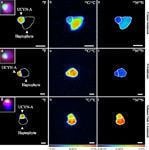Kingdom Bacteria Order Chroococcales | Phylum Cyanobacteria Rank Species | |
 | ||
Similar Trichodesmium, Cyanothece, Gloeobacter, Prochlorococcus, Acaryochloris marina | ||
Candidatus Atelocyanobacterium thalassa (previously cyanobacterium UCYN-A,) is a species of cyanobacteria commonly found throughout the world's oceans. Unlike many other cyanobacteria, A. thalassa lacks the ability to perform photosynthesis. Instead, it is found in a symbiotic relationship with photosynthetic algae. A. thalassa fixes nitrogen for the algae, while the algae provides carbon for A. thalassa through photosynthesis.
Contents
History
A. thalassa was first described in 1998 as a nitrogen-fixing bacteria with a much-reduced genome. The microbe was originally given the name UCYN-A for "unicellular cyanobacteria group A". In 2012, A. thalassa was described to be in a symbiotic association with the unicellular algae Braarudosphaera bigelowii and Chrysochromulina parkeae.
Biochemistry
A. thalassa lacks a variety of metabolic components common to cyanobacteria, including the oxygen-producing photosystem II complex of the photosynthetic apparatus, the carboxysome, enzymes of the Calvin and tricarboxylic acid cycles, as well as several enzymes involved in amino acid synthesis.
